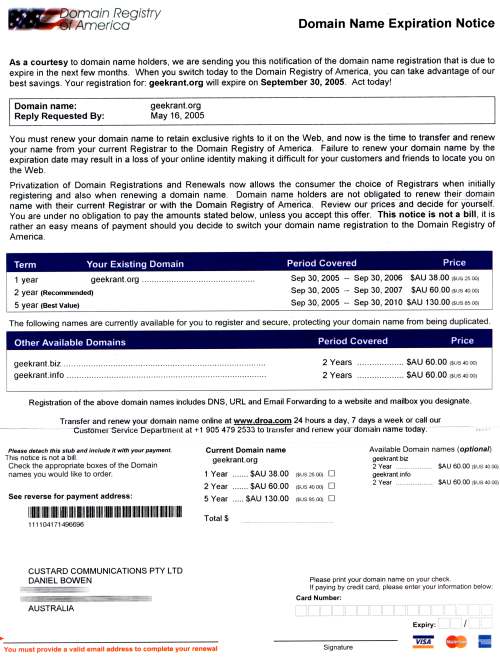I think someone hacked Newsgator’s “latest buzz” feature.


I think someone hacked Newsgator’s “latest buzz” feature.

A mate of mine, Nigel – the copywriter to the stars, sent me a Region 2 encoded DVD. My AV set-up is good, but the DVD player is dated. It’s a six year old Sony that is locked in to Region 4 and has no software unlock.
I tried the DVD in it anyway, ’cause sometimes R2 play in R4, but it didn’t work. I plonked it in my PC – Windows Media Player asked me to change the DVD drive region, leaving me with 4 changes. I tried it in the DVD burner, same thing. I tried to unlock it with DVD Shrink but that wanted me to change the region too.
Then I tried my least used media player – Real Player (get it from the BBC Real Player download page, it has no spyware or annoying ‘features’ if you get it from here) and it played the disc with no problems.
Dear Mr Gullible,
How would you like to renew your domain name at an exhorbitant rate with us?
Sincerely,
Borderline Fraud Department,
Domain Registry of America

One of the things I like about MS Access is the AutoNumber field type. And SQL Server has its Identity field type. Very handy for primary keys. But from time to time I convert applications into a more heavy-duty database, such as Oracle, where to do the same thing, you need to select from a sequence first. Here’s how to do an Autonumber-style field without mucking about with the sequence.
You do, of course, need the sequence, to track unique IDs.
CREATE SEQUENCE [Schema].[SequenceName] START WITH [Number] INCREMENT BY [Number] MINVALUE [Number] NOCACHE NOCYCLE;
NoCache will avoid skipping values due to Oracle creating any numbers in advance. NoCycle avoids the number repeating itself. I generally name my sequence after the field it’s being used for, with an _SEQ suffix.
Putting the sequence number into the field is done by a trigger:
CREATE TRIGGER [TriggerName]
before insert on [TableName]
for each row
begin
select [SequenceName].nextval into :new.[ColumnName] from dual;
end;
Easy!
There is a catch. While in Access or SQL Server there are easy ways to find out the value of the AutoNumber/Identity field in the row you just added (through @@IDENTITY in SQL Server or in Jet 4.0 or later), this isn’t so easy in Oracle.
You can query the column’s MAX value or the sequence CURRVAL afterwards — but this isn’t reliable if yours is not the only process inserting data. Would it work if you placed your code in a transaction? I’m not convinced.
So the trigger method should only be used when you don’t need to know the number entered straight afterwards. If you need to know, then forget the trigger — just select your Sequence value first, then use that in your insert(s).
Mainstream support for Visual Basic 6 (the last version before .Net) finished at the end of March, and there’s growing murmurs in the VB development community, calling for it to be resurrected. While “classic” VBers didn’t mind being shunted into the .Net framework, they objected to some of the bigger changes to the language itself, which made it difficult to migrate old projects over. And remembering that “classic” VB is the most popular computer language ever, there’s a lot of old systems out there still running with it. A petition has been organised, with nearly 200 MVPs having signed up so far.
Microsoft have put up a new site highlighting VB6 called VBRun (harking back to the pre version 5 days when the main DLL was called VBRun). It’ll have VB6 content on it, as well as nudging developers towards .Net.
I work with VB. I’ve got a lot of VB6 code still running. But I’m slowly moving some stuff over to .Net. I’m not convinced it’s better yet. It’s certainly different, but I’ll get used to it eventually.
This wasn’t quite geeky enough to be a geek rant, but I’ve blogged about the changes to TV broadcasting brought about by file sharing (in particular BitTorrent) here: TV in the global village.
As someone who administers a number of databases, I’d say to anyone that you need a damn good reason to put non-standard values into a field.*
Today’s curse is sorting out the “Counties” field, which is supposed to be used to show British counties. To add insult to injury, people have to select from a drop-down menu, and if they try to type in a value that doesn’t exist, they are specifically asked if they mean to add that value (methinks the database is not locked down quite tightly enough, but I can’t control that bit at the moment).
People, let me tell you, from even basic general and geographical knowledge: Austria, Australia, BD20 0DX, Bahrain, Brentwood, Brighton, Jacksonville Canada, NW10 0HD… none of these are British counties, nor were they ever, nor will they ever likely be.
* That good reason doesn’t exist. The same goes for towns, titles, gender, and a whole host of other fields with clearly defined standards.
While Cam and Mick at The Podcast Network are doing great things, I have niggling doubts about the long-term prospects for podcasting. Darren Barefoot has expressed some of them. My niggling doubts primarily come from the differences between blogs and podcasts, and the technical limitations of podcasting.
So will podcasting go mainstream? Will it knock radio off its roost? Or did video already do that? 🙂 Will the technical limitations be overcome? It’ll be interesting to see how it pans out in the long term.
Who said it’s only Apple that can make great looking computers? Alienware is now selling in Australia.
Want to look back at GUIs of the past? Check out the Graphic User Interface gallery. (via Phil)
With hard drives getting smaller (in size) and bigger (in capacity), some are predicting 20Gb iPod Minis aren’t far away.
At last, one of my longest standing tech dreams has been realised. I can finally sync my phone with Outlook. I know you’ve been able to do this for years but up until today I’ve never had the means to. Two weeks ago I got a great new Nokia 6230 so I purchased a connector cable off Ebay which arrived today. I could have used Bluetooth for my connection but this chews through battery life (more of which shortly) and a cable was cheaper than an IR usb adaptor. Now I have all my contacts and calendar information for the next 12 months wherever I go.
“But surely you had all this in your Ipaq?” I hear you ask. I did, but in an effor to simplify my life and reduce the bulge in my left pocket I am increasingly leaving it home in favour of my Hipster PDA. Another reason for relying less on the iPaq is the Pocket PC version of Microsoft Money never really synched with my desktop version and tracking finances on the go was one of the major reasons I wanted a PDA. Now I simply keep my receipts in my wallet until I get home.
While I love my new phone, I’ve even set it up so I can email photos from it direct to Flickr (see my test shot), I am not impressed with the battery. It advertises 300 hours of standby – I get 48. I’ve tried to get it replaced but am having nightmare time as Optus and Nokia shuffle responsibility. All I want is a new battery and they will never hear from me again.
 My iPod is back, and I decided to get a case for it. ‘Cos what with carrying it about, and the kids playing with it, I figured it could do with some protection, as well as a belt clip.
My iPod is back, and I decided to get a case for it. ‘Cos what with carrying it about, and the kids playing with it, I figured it could do with some protection, as well as a belt clip.
After looking about at the various products, and with Tony’s recommendation, I looked at the iSkin. They appear to have gone all out to design something that’s both practical and fairly visually appealing (though to be fair, nothing beats the look of the iPod itself — even down to the normally fugly things like the power supply, Apple have created something that is utterly beautiful).
iSkins are not cheap, at least not to those of us trading in the Australian Peso. A little shopping around showed a price of between A$49 and $59. Unfortunately the $49 price was at Streetwise, whom I have had recommended to me, but are not particularly conveniently located, and even if they were, have been closed this past weekend for moving. And I wanted my iSkin straight away. Likewise, Streetwise’s or Apple’s online shop could have sold me the product, but online shopping for physical items doesn’t give you instant gratification.
So I coughed up the $59 at the AppleCentre on Flinders Street. Took the skin back to my iPod, and then wrestled with it for about half an hour, trying to figure out how it opened.
See, in looking at the adverts and catalogues, I’d got it into my head that the iSkin was made of some kind of rigid plastic. It isn’t. It’s flexible, and you’re meant to get the iPod (and the instructions and other items in the packet) in and out by way of the gap for the screen.
When I figured this out, I found the instructions inside telling me so. WhyTF they couldn’t put a hint on the outside of the package, I don’t know. Would have saved me a bit of fiddling about.
Oh well, the iSkin is lovely, though I don’t think much of (and am not using) the “free bonus” click-wheel cover they included. The other downer: it can plug into its USB/firewire connection while in the skin, but it’ll have to come out to fit into the dock.
But hopefully it will keep my iPod safe from the ravages of the world.
Google have announced they are doubling the storage limit of Gmail to 2Gig and will then increase the storage limit on a daily basis, with no view to stopping.
Surely every person on earth must have an invitation by now, but if you don’t just let us know in the comment and you too will soon be experiencing the ever expanding goodness that is a Gmail account.